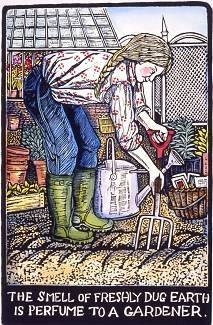
Plant: After you harvest the last of the cool-weather crops, you can still take advantage of Napa's long growing season. Corn, beans, cucumbers, eggplant, melons, peppers, summer squash and tomatoes are all warm-season crops to consider putting into those vacant spots. Pumpkins planted now will ripen in time for Halloween. Green beans require trellising or staking unless you plant bush varieties, which only grow about two feet high. This year my flowering maple (Abutilon hybridum) has taken off. It is blooming profusely, and it needs some sort of support system to keep it from flopping over.
Stake your tomatoes or place wire cages over the vines to keep fruits from resting on the ground and spoiling. Feed tomato plants when the first fruits form. Use a low-nitrogen fertilizer to encourage fruit over leafy growth. As tomatoes ripen, take care not to overwater. Too much water can cause fruits to crack.
Don't forget to plant basil along with your tomatoes. This herb does well in flower beds and in containers. Last year I enjoyed growing Thai basil (Ocimumbasilicum var. thyrsiflora) in addition to the more usual sweet basil (Ocimumbasilicum). Thai basil plants and leaves are smaller than sweet basil, but the flavor is more intense, with a touch of licorice. This is the variety often used in Southeast Asian dishes, such as Thai curries. Pinch off flower heads as they form to prevent plants from going to seed. Initially, after six to eight leaves form on a stem,prune that stem back to two leaves. The plant will be happier and bushier for it.
Water: As we head into our third year of drought conditions, checking sprinkler systems should be at the top of your “to do” list. Mulch your plants to minimize weeds and maintain soil moisture. Water early in the day to prevent fungus and mold problems.
While established native oaks usually need no summer water, other shade trees will have a better canopy if you give them a deep soak in mid-June and again in mid-August. Water enough to moisten the soil to a depth of three feet (usually four to six inches of water). Established shrubs maintain a good appearance without producing too much growth if watered to a depth of three feet once a month.
Most fruit and nut trees need more water to produce good crops. Irrigate to a depth ofthree feet every other week. Bedding plants and lawns, being shallow rooted, require even more water. A minimum of three-quarters of an inch every four days would be normal in June. Days with dry north winds or temperatures above 100°F create the need for more water, especially for shallow-rooted plants. Increase watering frequencywhen those conditions prevail.
Deadhead flowers: On plants that bloom repeatedly, remove withered flowers to encourage re-bloom. Roses, daylilies, geraniums and marigolds all benefit from this practice, known as deadheading. Roses also appreciate a feeding with a balanced fertilizer after that first flush of bloom.
Thin fruit: Thin peaches and nectarines to allowsix to eight inches between fruits. I neglected to do this one year, and I had lots of peaches that were more pit than peach. Also remove any fruits that are joined together.
Prune: Spring-flowering shrubs and vines often bloom the following year on new wood that they produce after bloom. So early summer is a good time to prune back and shape these plants, such as azaleas and rhododendrons, bridal wreath spirea(S.vanhouttei), forsythia (forsythia x intermedia), hawthorn (Crataegus species and cultivars), star jasmine (Trachelospermumjasminoides), magnolia(Magnolia species and cultivars), and mockorange (Philadelphuscoronarius).
Workshop: Napa County Master Gardeners are conducting a workshop on “Structures in the Garden” on Saturday, June 7, from9:30 a.m. to 11:30 a.m. Do the beautiful flowers in your garden need extra support? At this workshop you will learn how to make your own support systems for the garden. Workshop location is the Master Gardener Demonstration Garden,Connolly Ranch Education Center, 3141 Browns Valley Road in Napa. Online registration (credit card only); Mail in registration (cash or check only).
Master Gardeners are volunteers who help the University of California reach the gardening public with home gardening information. Napa County Master Gardeners ( http://ucanr.org/ucmgnapa/) are available to answer gardening questions in person or by phone, Monday, Wednesday and Friday, 9 a.m. to Noon, at the U. C. Cooperative Extension office, 1710 Soscol Avenue, Suite 4, Napa, 707-253-4143, or from outside City of Napa toll-free at 877-279-3065. Or e-mail your garden questions by following the guidelines on our web site. Click on Napa, then on Have Garden Questions? Find us on Facebook under UC Master Gardeners of Napa County.
Napa County Master Gardeners welcome the public to visit their demonstration garden at Connolly Ranch on Thursdays, from 10:00 a.m. until noon, except the last Thursday of the month. Connolly Ranch is at 3141 Browns Valley Road at Thompson Avenue in Napa. Enter on Thompson Avenue.